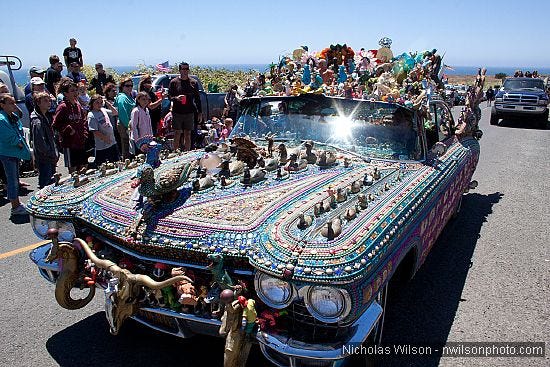
“A hippie is someone who dresses like Tarzan, has hair like Jane, and smells like Cheetah.”
Governor of California Ronald Reagan, 1967
"We called them rednecks and they called us dirty hippies."
Newcomer research participant
Every old-timer participant in this study noted they encountered hippies who were dirty and smelled bad. One wrote:
“My mom picked up a hippie hitch-hiking back from town, and I can still remember how the patchouli oil and B.O. stunk up the truck.”
Differences cited by old-timer respondents about the newcomer hippies also included:
colorful psychedelic dressing
braless women with underarm hair
men with “shaggy un-combed beards”
a bad smell attributed to patchouli oil and body odor
A participant who was a hippie kid during the Seventies wrote:
“A glimpse would reveal which side one belonged to. Dress primarily. Hair length and style. Most newcomers had old cars.”
The kind of vehicle driven identified whether one was an old-timer or newcomer. No car also noted differences, as some hippies relied on hitch-hiking to get where they needed to go. Old-timers generally had newer vehicles in good repair. The cars, trucks, and vans driven by back-to-the-landers seemed to be in consistent need of repair.
Along with outward appearances, newcomers also observed old-timers had different attitudes. Newcomers felt old-timers were territorial and provincial, one wrote:
“Lack of exposure to the outside world, many had never been out of the area. I observed some ‘closed mindedness’ and inability to accept or tolerate people who weren’t like them.”
In an interview, one old-timer respondent told me his impression of newcomers:
Some hippies were real nice, stayed clean and were sociable, others looked real ratty—they had long hair never combed, long beards never trimmed. Some set up camp any place they felt like it, some squatted in old saw mill cabins, and that caused resentment. A lot of them I got to know, even though they were seedy-looking, but they never bothered me. They were interesting to talk to. It depended on the individual person.
Differences were also apparent in the realm of volunteering at community benefit functions. A newcomer respondent wrote that when volunteering in the Grange Hall kitchen during a benefit dinner, she felt unable to clean the kitchen counter to the standards set by old-timer women at the Grange.
“And then, there is pie crust,” wrote an old-timer respondent. “The old-timers tried to teach the hippie mommas how to make pie crust right, but they kept making it with whole wheat flour. It tasted like cardboard.” Home made pies was, and still is, a key part of the community’s fundraising traditions.
Differences in social origins and economic status were also noted. Looking back, one one old-timer said, “Every hippie I ever knew came from some sort of affluence.”
In Hippies and American Values (1991), Timothy Miller addresses status, writing that the appeal of the counterculture pointed to a social status voluntarily left behind.
“Some of the hippies who talked the most about the abolition of money were children of privilege for whom the grinding reality of real want was nonexistent. The poor rarely found their young turning into hippies”.
As discussed in this series in posts found in chapters 1 and 2, hippies dropped out of mainstream America en masse. Most had grown up in the middle class, which is what they were leaving behind.
Some of the differences identified are humorous in hindsight. But in the ethnographic present of the Seventies, the differences between immigrating newcomers and established old-timers caused community conflict that lead to social exclusion. While the conflict never grew violent, it was unpleasant, sometimes obnoxious, and created unnecessary distance between people.
Although the differences were real, they were also superficial. The unnecessary social gap was eventually bridged. Some of the newcomers lived just a short time in this new paradigm. But for those who committed to their land and new way of life, relationships emerged that spanned differences in the other.
Once newcomers and old-timers became acquainted through work relationships, volunteering, and attending community functions, they began to accept one another. In time, life-long friendships were forged.
Up next: Land use
Resources for this post:
Miller, Timothy, 1991. Hippies and American Values.







Thank you Francene. I appreciate your comments, it’s good to know I’m reaching people. I know you were one of the Young during this time and you know the counterculture movement by experiencing it. So your comments are a blessing of support. Thanks Francene!
Your writing all has the ring of truth, Lisa. Thank you for sharing.